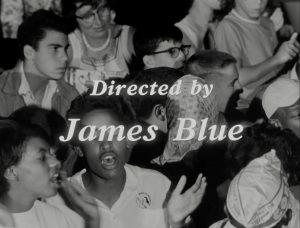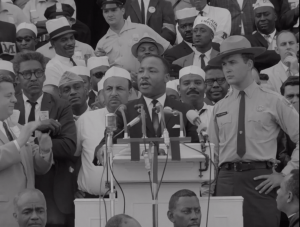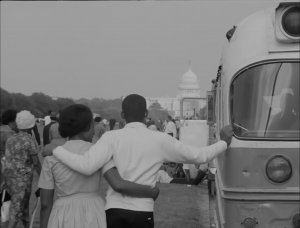Introduction
About
The digital exhibition The March is the result of a collaborative project led by David A. Frank (Professor of Rhetoric and Mellon Faculty Fellow), the University of Oregon Libraries, and the Jordan Schnitzer Museum of Art, with individual contributions by members of both institutions (see below). This exhibition received inspiration and support from The James Blue Project, a research interest group at the University of Oregon devoted to creating a “living archive” from materials relating to the James Blue papers in UO Libraries’ Special Collections and University Archives.
Although this is a collaborative project, the intellectual content is primarily David Frank’s, and it does not necessarily represent the views of the University of Oregon, the University of Oregon Libraries, or the Jordan Schnitzer Museum of Art.
The project was supported in part by The Andrew W. Mellon Foundation through the grant-funded initiative “Leveraging GLAM Assets in Research, Teaching, and Learning: Mellon Faculty Fellowships to Advance Library-Museum Collaboration.” Adriene Lim, Dean of Libraries and Philip K. Knight Chair, University of Oregon Libraries, and Jill Hartz, Executive Director of the Jordan Schnitzer Museum of Art, are co-PIs for the grant. The initiative’s purpose is to foster collaboration between UO Libraries and the Jordan Schnitzer Museum of Art through a program of small grants for faculty research projects that draw on the collections and/or expertise of both institutions. Jenny Kreiger, Mellon Postdoctoral Scholar in Library-Museum Collaboration, manages this initiative.
James Blue and the Making of The March

James Blue’s The March (1964) is a humanistic and poetic 33-minute film of the August 28, 1963, March on Washington for Jobs and Freedom, produced and distributed to 83 foreign countries by the United States Information Agency (USIA).
James Blue (1930-1980) was born in Oklahoma. His family moved to Portland, Oregon, when he was 13. He struggled with a racist mother who was a member of the John Birch Society. He graduated from Portland’s Jefferson High School and then, in 1953, from the University of Oregon, with majors in theater and speech. At the UO, Blue was a student of Horace Robinson in theater, Robert D. Clark in speech, and Glen Starlin in radio and television (Blue starred in several plays and worked for KWAX radio station as a producer). Blue and James Ivory (who would later emerge as a major figure in the film world) learned French in the same classes. Robinson, Clark, and Glen Starlin recommended Blue for the prestigious graduate program at the Institut des hautes études cinématographiques (IDHEC) in Paris.
After directing The March, Blue went on to interview seventy of the most important movie directors of the 20th century and to produce, among many short films, an Academy Award-nominated film.
To learn more about James Blue’s life, check out The Making of James Blue. For more on James Blue’s creative process and how he made The March, see The Making of The March.
The Civil Rights Movement and The March

Historians agree that the March on Washington was a high point of the long Civil Rights Movement.
Blue’s film of the March captures the movement’s rhetorical signature, which includes explicit condemnations of racism and federal inaction joined to an anti-racist platform that included a commitment to nonviolence, a prophetic theology, the use of protest spirituals, interracial collaboration, a dedication to constitutional ideals, and carefully calibrated condemnations of American apartheid yoked to a vision of America’s promise.
Blue’s film features the planning of the March of Washington, which was the responsibility of Bayard Rustin (shown to the left of King in the image above), and the soaring oratory of Martin Luther King.
To learn more about the broader Civil Rights Movement, see Making the March on Washington and check out the videos on Meaning of the March.
Lyndon B. Johnson and Responses to The March

When The March was released in early January, 1964, it was condemned by southern senators and the USIA Advisory Committee chair for suggesting that African Americans remained in slavery.
President Lyndon B. Johnson watched the film on January 19, 1964. Keen to pass the Civil Rights Act of 1964, he feared that southern senators might withhold their votes to protest the film’s depiction of the United States as a racist country. In a February 6, 1964, conversation with the NAACP’s Roy Wilkins, Johnson said he had “a real difficult problem” with The March, although he affirmed the film’s positive qualities.
Many critics today believe that the film is ahistorical, holding that it depicts interracial harmony as a norm and that it airbrushes and sanitizes the conflicts within the civil rights movement and the intransigence of the Kennedy administration. They note that in the immediate aftermath of the March, American apartheid remained intact.
For more on responses to The March, see LBJ’s “Difficult Problem” and Conflicted Legacy.